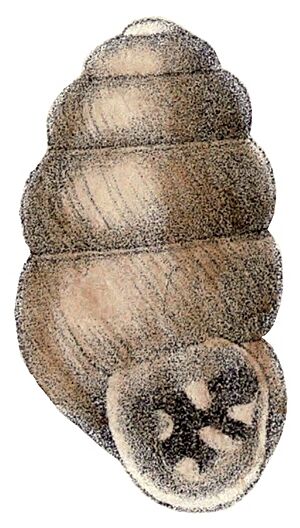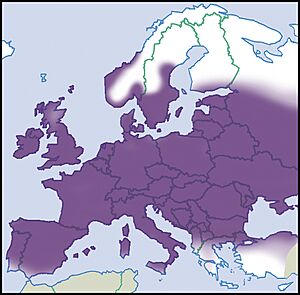Vertigo pygmaea facts for kids
Vertigo pygmaea, also known as the crested vertigo, is a super tiny air-breathing land snail. It's a type of mollusk that lives on land, belonging to a family called Vertiginidae, which are often called whorl snails.
Quick facts for kids Vertigo pygmaea |
|
|---|---|
 |
|
| Apertural view of a shell of Vertigo pygmaea | |
| Scientific classification | |
| Synonyms | |
|
Contents
Shell Features
This snail has a really small shell, shaped like an oval cylinder. It's usually a deep brown color and feels smooth, not shiny. The top part of the shell, called the spire, has five turns, or whorls.
The opening of the shell, called the aperture, is almost round. It has four small "teeth" inside. One tooth is sharp and at the top. Two others are deeper inside, and one is on the columella (the central pillar of the shell). Sometimes, there's even a fifth tooth at the bottom of the opening. The edge of the opening, called the peristome, is slightly bent outwards. There's also a clear little groove near the belly button area of the shell.
The shell is also very finely ridged and looks a bit glossy. It has about six whorls that grow slowly. The first three whorls form a rounded top. The last three whorls are about the same height and make up the main cylindrical part of the shell. The very last whorl, where the snail lives, is not thick or squeezed before the opening.
The opening is about a quarter of the shell's total length. It's curved and might have a slight dip on the outside. The teeth inside are reddish and often hard to see. There's one tooth in the middle of the inner wall, one on the columella, and sometimes two very faint ones on the outer wall. The edge of the opening is continuous and a bit wider.
An adult shell is usually about 1.1 to 1.25 millimeters wide. It stands about 2.4 to 2.7 millimeters tall. These tiny snails often live under hedges.
Where They Live
You can find Vertigo pygmaea in many places around the world.
In Europe
This snail lives in many countries and islands across Europe, including:
- Czech Republic
- Netherlands
- Poland
- Slovakia
- Ukraine
- Great Britain
- Ireland
- Latvia
- And many other places!
In America
They are also found in various parts of America, for example:
- Michigan - Here, they are considered a species of "special concern," meaning they need a bit of extra attention to make sure their populations stay healthy.



